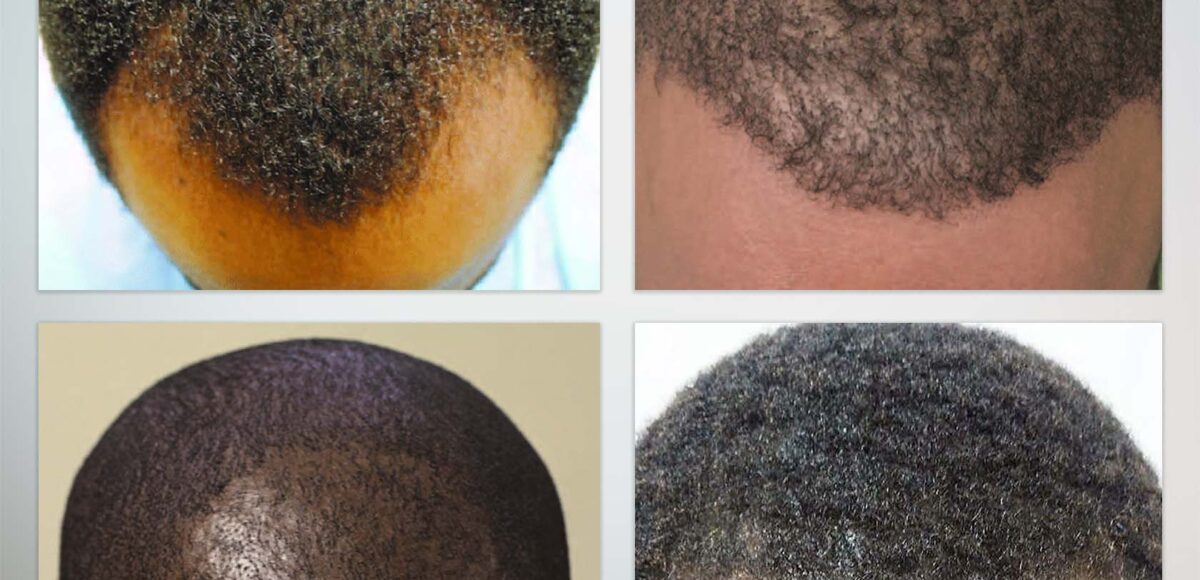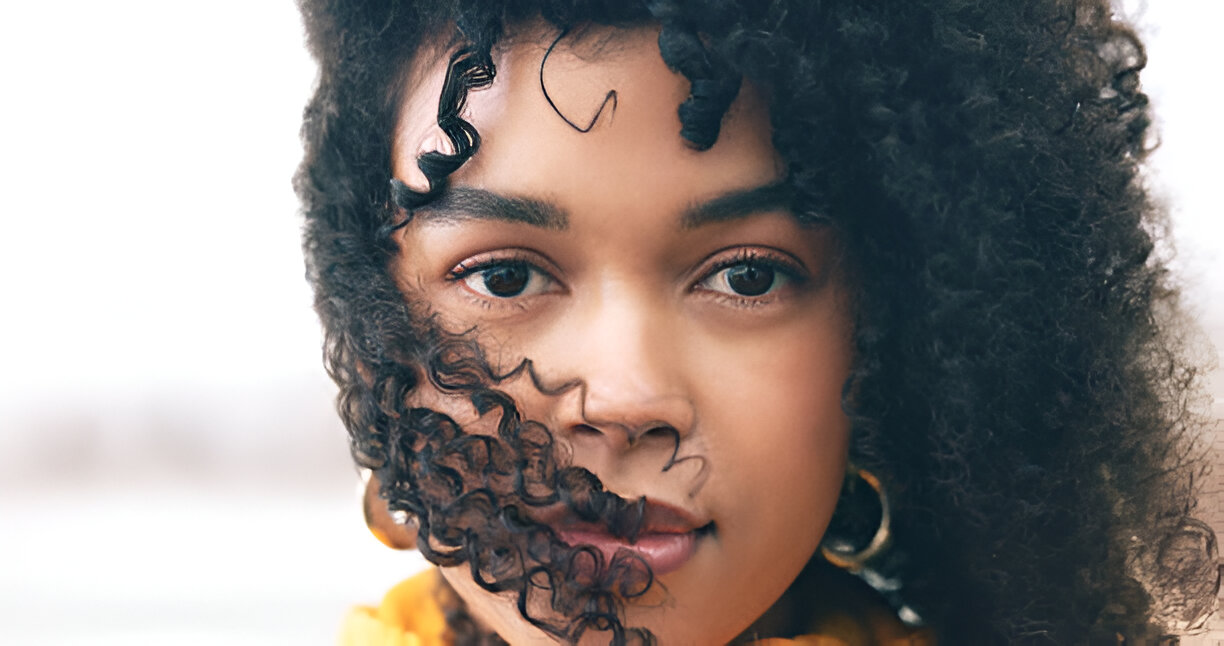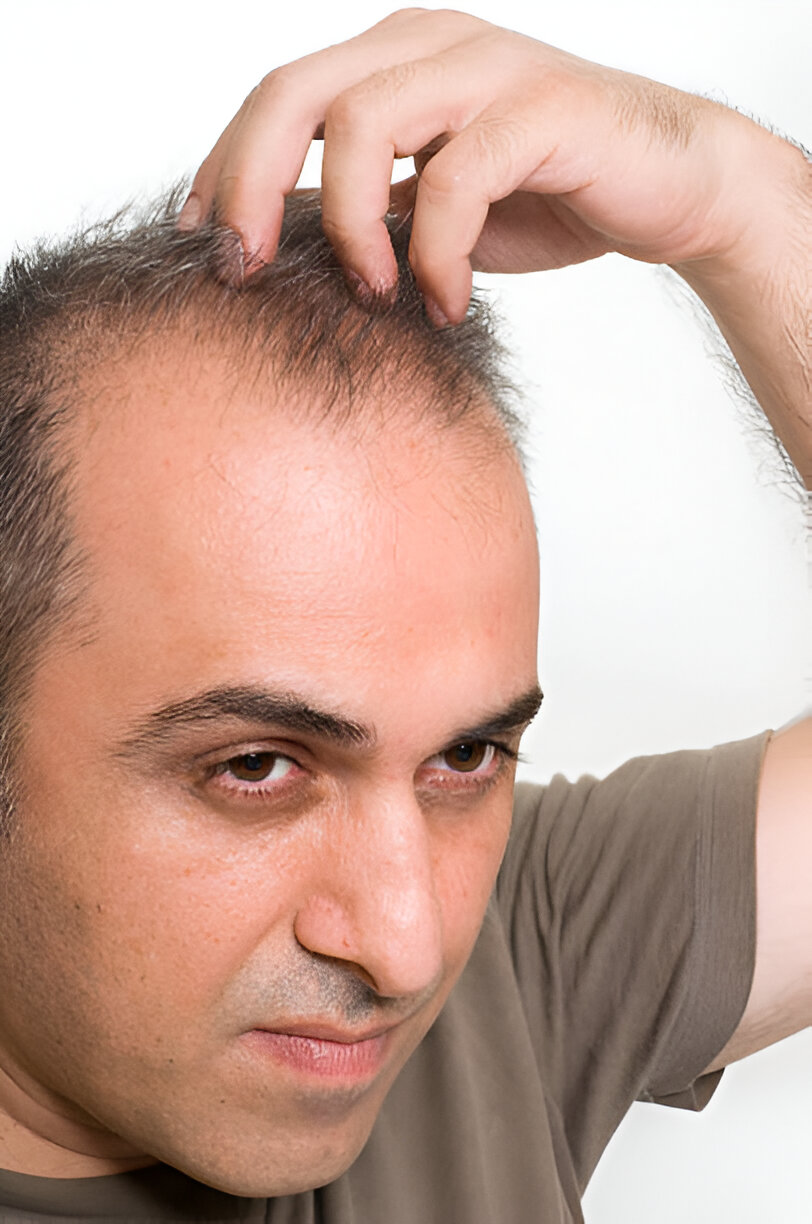
Hair Transplant for Afro-Textured Hair: Unique Considerations
Hair Transplant for Afro-Textured Hair: Unique Considerations
Hair Transplant Challenges for Afro-Textured Hair
Learn the unique considerations for hair transplantation on Afro‑textured hair—curl pattern, curved follicles, extraction tools, graft placement, scarring risk, and specialist surgeon importance.
Understanding Afro-Textured Hair
Learn why afro hair’s tight coils and curved follicles require a tailored surgical approach for natural-looking results.
Common Causes of Hair Loss
Explore why traction alopecia and CCCA are more common in afro-textured hair, and how early diagnosis can improve outcomes.
Choosing the Right Technique
Discover whether FUE or FUT is the better option for your hair type, scalp health, and desired style.
Hair Transplants for Afro-Textured Hair: What You Need to Know
Hair loss can affect anyone. It doesn’t matter who you are or where you’re from—it just happens. But if you’ve afro-textured hair, navigating your way back to fuller, healthier strands? That’s a whole different ball game.
Let’s be real; transplants are everywhere now. Scroll through your feed, and you’ll see a flood of clinics promising miracle makeovers. But here’s the thing: most of them aren’t talking to you. Afro hair isn’t just different—it’s delicate, tightly coiled, and requires a surgeon who genuinely understands it. This isn’t just about putting hair back where it’s gone. It’s about honouring the curl pattern, respecting your scalp, and achieving results that look natural.
That’s exactly why we’ve put this guide together. We’re not here to gloss over things—we’re here to walk you through it properly. From what makes afro hair so special to why traction alopecia and CCCA are common culprits, and even whether FUE or FUT suits you best, you’ll find it all here—honest, practical advice, no fluff.
Importantly, we’ll highlight the importance of working with specialists who truly understand afro hair. You’ll learn what to consider before and after surgery, explore non-surgical alternatives if a transplant isn’t ideal, and understand how to choose a clinic that respects and caters to your hair type, putting you in the driver’s seat of your hair restoration journey. Finally, we’ll introduce you to Merchant City Medical Group—a trusted name in personalised Afro hair restoration.
Let’s get started.
What Makes Afro-Textured Hair Unique?
Understanding afro-textured hair is the first and most critical step before considering a transplant. It’s not just about the hair on the surface—what’s going on underneath the scalp makes all the difference when it comes to extraction, handling, and the survival of each graft, which refers to the percentage of transplanted hair that successfully grows in its new location.

Curl Pattern and Follicle Structure
Afro-textured hair typically grows in tight coils, and beneath the surface, the follicles are often curved or hooked. This makes harvesting each graft more delicate and prone to damage if not done with extreme care. The unique shape also impacts how hair grows out of the scalp, making it essential for surgeons to replicate the natural angle and direction.
Hair Density and Growth Patterns
Afro hair is often densely packed, but this doesn’t always translate into a higher number of usable grafts. The distribution and spacing of follicles can vary significantly, and transplant planning must take this into account. Misjudging this density could lead to overharvesting or sparse results.
Scalp Sensitivity and Skin Type
Afro-textured individuals often fall into Fitzpatrick skin types IV to VI, which can be more prone to hyperpigmentation, ingrown hairs, or keloid scarring. Therefore, selecting the right surgical technique and postoperative care is vital for optimal healing.
What Causes Hair Loss in Afro Hair Types?
Afro hair faces its own set of stressors—both environmental and cultural. Before undergoing a transplant, it’s essential to identify the underlying cause of the hair loss.
Traction Alopecia from Tight Hairstyles
This is one of the most common culprits. Repeated tension from braids, cornrows, weaves, and tight ponytails can cause the hairline—especially around the edges—to thin over time. If caught early, the damage may be reversible. Without proper treatment, the condition may lead to permanent follicle loss, a condition that can only be resolved through surgery.
Central Centrifugal Cicatricial Alopecia (CCCA)
Central Centrifugal Cicatricial Alopecia (CCCA), which predominantly affects Black women, tends to develop at the crown and spread from there. It’s tricky because it destroys hair follicles and replaces them with scar tissue. While some cases can be treated medically, a transplant may not be an option if the scarring is too extensive.
Male and Female Pattern Baldness in Black Patients
Androgenetic alopecia affects all ethnicities, but in afro hair types, it often shows differently—less recession at the temples and more diffuse thinning across the scalp. Transplants are still a solution, but a customised approach is required.
Is Hair Transplant Suitable for Afro-Textured Hair?
It can be, but only under the right conditions. Suitability doesn’t just depend on hair loss. It’s a careful mix of scalp condition, expectations, and surgical approach.
- Key Candidacy Factors
You may be a good candidate if you have sufficient donor hair, a healthy scalp, and realistic goals. A proper diagnosis is essential—your surgeon should rule out active scalp conditions such as psoriasis, eczema, or seborrheic dermatitis, or scarring diseases like lichen planopilaris or discoid lupus erythematosus, that could affect the results. - FUE vs FUT for Afro Hair: Which One Works Better?
Both techniques have their merits. Follicular Unit Extraction (FUE) involves removing individual grafts, leaving minimal scarring; however, it’s technically challenging due to the curved follicles. In contrast, Follicular Unit Transplantation (FUT) involves removing a strip from the donor area and may be more effective for certain patients with tight curl patterns, as it reduces the risk of follicle transection.
The best method often depends on the surgeon’s skill and the patient’s specific hair and scalp characteristics. - When Hair Transplant Is Not Recommended
If there’s active scarring, inflammation, or widespread thinning without a viable donor area, surgery may not be the best option. In such cases, non-surgical options such as scalp micro-pigmentation or medical treatments like minoxidil or finasteride may offer better results without the risks associated with surgery.

Why Afro Hair Requires Expertise
This isn’t a job for just any clinic. Afro-hair transplants demand experience, patience, and the right equipment. Here’s why that matters.
- Why Experience Matters
Inexperienced surgeons may damage the curved follicles during extraction, leading to poor growth or patchy results. A seasoned professional understands how to angle tools, minimise transection rates, and replicate the natural flow of afro-textured hair. Tools and Technology for Curly Hair Follicles
Specialised tools, such as wider punches or curved blades, are often required to extract grafts safely. Clinics without this equipment may struggle to achieve acceptable results.Realistic Expectations and Patient Education
A good surgeon will always provide you with a clear and honest view of what’s achievable. Afro hair may offer excellent coverage with fewer grafts due to its curl volume, but density limitations and healing speed vary. Managing expectations is part of the journey.
Pre-Transplant and Post-Transplant Considerations
The work doesn’t start or stop in the operating room. What you do before and after your procedure can significantly affect your outcome.
Scalp Preparation and Consultation Process
A thorough consultation should include a scalp examination, blood tests, and, in some cases, a biopsy to rule out autoimmune conditions. This comprehensive approach ensures that your surgeon has a complete understanding of your unique hair and scalp characteristics, leading to the best possible outcome. Pre-op care may involve using topical treatments or antibiotics to prepare the skin.- Post-Operative Care for Afro Hair
After surgery, the scalp must be treated gently. Avoid tight hairstyles, harsh products, and scratching the area. Use sulphate-free shampoos and follow any medicated treatment plans provided. Risk of Scarring and How to Prevent It
People with darker skin are at a higher risk of hypertrophic or keloid scarring. Keeping the scalp clean, avoiding trauma, and regular follow-ups can help minimise these risks.
Real Results: What to Expect After Transplant
It’s important to know what’s normal during the recovery and regrowth process. Patience is key.
Hair Growth Timeline for Afro Hair
As scabs begin to fall off naturally and the redness reduces, you’ll likely be able to sleep flat again. If your scalp feels tight, itchy, or sore, give it time to recover. Don’t rush into your old routine if it risks your results.Texture Match and Natural Appearance
The curl pattern of the transplanted hair will remain the same; however, placing it at the wrong angle can compromise the natural look. Proper technique ensures that new growth blends seamlessly with the surrounding hair.
Long-Term Maintenance and Scalp Care
Continue using gentle, hydrating products. Avoid over-manipulating your hair. Regular check-ins with your transplant clinic can also ensure ongoing success.
Alternatives for Afro Hair Loss if Transplant Isn’t an Option
A transplant isn’t the only solution—and for some, it may not be suitable at all. Thankfully, there are proven alternatives.
Platelet-Rich Plasma (PRP) Therapy
Platelet-Rich Plasma (PRP) uses your blood plasma to stimulate hair growth and strengthen follicles. It’s particularly useful for early-stage hair loss or areas that are thinning but not fully bald.

Scalp Micropigmentation (SMP)
Scalp Micropigmentation (SMP) is a non-invasive procedure where tiny pigment dots are applied to replicate the appearance of closely shaved or fuller hair. It’s great for camouflaging thinning areas or creating the illusion of a fuller hairline.

Topical and Oral Medications
Both minoxidil and finasteride are effective options for preventing further hair loss and promoting regrowth. Supplementing with biotin, iron, and other hair-friendly nutrients may also support healthy hair, especially when combined with professional guidance.
How to Choose the Best Clinic for Afro Hair Transplants
Selecting a clinic isn’t just about price—it’s about results, safety, and experience with afro hair.
Questions to Ask Before Booking
- Have you performed transplants on afro-textured hair before?
- What’s your graft transection rate?
- Do you offer both FUE and FUT?
- Can I see before-and-after photos?

Importance of Before-and-After Photos
Galleries should include patients with similar hair types. If they can’t show relevant results, you might want to look elsewhere.
Why Choose Merchant City Medical Group for Afro-Textured Hair Transplants?
Expert Afro-Textured Hair Restoration in the UK
Merchant City Medical Group is one of the few UK clinics with deep expertise in afro-textured hair restoration. Their personalised approach, advanced tools, and track record of success make them a standout option for patients seeking reliable, natural results.
- Experience With Afro-Caribbean Hair Types
Their surgeons have successfully treated numerous African-American hair clients—both men and women—using both FUE and FUT methods tailored to individual needs. - Tailored Consultation and Care Plans
From your first consultation to the final follow-up, Merchant City Medical Group ensures that each step is tailored to your specific hair, skin, and lifestyle needs. - Natural Results and Positive Reviews
With hundreds of satisfied clients and a library of impressive before-and-after results, you’ll be in capable hands. Booking a Free Consultation
Ready to take the next step? Book a free, no-obligation consultation with Merchant City Medical Group today and discover the best solution for your unique hair journey.
Excellence Record
- 30+ Years of combined experience
- 10 + Experts
- 1000 + Satisfied Patients




